Die Amerikaner in Fürth 1945 - 1995
- Besatzer - Nachbarn - Freunde - Exhibition in the former dormitory of the Nurnberg American High School from 13 September to 10 October 2018
Trustee Bernd Jesussek Ausstellung im früheren Wohnheim der Nurnberg American High School vom 13 September bis 10 Oktober 2018
Kurator Bernd Jesussek The
panels give an idea of the influence that the US Army had on the city
of Fuerth - as occupying forces, neighbors and friends.
(Translation via Google, I apologize for any mistakes or misunderstandings)
The panels were part of the exhibition of the city of Fuerth "200 Years Of Independence", Sept./Oct. 2018. The additional catalogue was published by the
City of Fuerth, BMPA, with 60 pages and 99 photos. Die Tafeln skizzieren den Einfluss der US Army auf die Stadt Fürth - als Besatzungsmacht, als Nachbarn und Freunde.
Die Tafeln waren Teil der Ausstellung der Stadt Fürth zum Thema "200 Jahre eigenständig", Sept./Okt. 2018. Der Ausstellungskatalog wurde vom Bürgermeister- und Presseamt der Stadt herausgegeben. 60 Siten mit 99 Fotos.
|
 | US soldiers in Fürth
Since the end of the war in 1945, soldiers from the US Army had been stationed in the three barracks in
Fuerth. For fifty years, an average of around 10,000 American citizens lived in Fuerth and the surrounding
area and influenced the way of life and the cityscape. The last soldiers of the US Army left Fuerth around
twenty-five years ago.
At the end of the Second World War, the 42nd US Infantry Division marched into Fuerth. The Americans
dissolved the National Socialist authorities and tried to stabilize public life again. It soon became
clear that American soldiers would stay in Germany permanently. In order to create living space for them
and their families, the Kalb Housing was built and schools and shopping centers were built. Together with
other barracks, the "Nurnberg Military Community" was created.
From the point of view of the people of Fuerth, the Americans changed from strict occupiers to allies of
Germany and they got used to each other. The American soldiers stationed far from their homes sometimes went
over the limit, but on the other hand the US Army protected Germany from the Eastern Bloc. Fürther valued
facets of the “American way of life” and many Americans got to know the Bavarian “cosiness”. A number of
friendly relationships developed. After the German reunification in 1990 and the end of the Warsaw Pact
threat to Germany, the American government reduced the number of soldiers stationed abroad because of the
high costs. In addition, in many German cities - not really in Fuerth - there was a strong effort to get
rid of the previous protectors. Therefore, a number of barracks were gradually given up.
With the withdrawal of the last US soldiers from the Fuerth William O. Darby barracks on December 19, 1995,
the city lost a not insignificant economic factor and employer. However, the barracks freed up gave the
opportunity to attract new branches of the economy and a larger population. The city of Fuerth has
implemented the conversion of US properties into apartments in Südstadtpark and in industrial settlements.
The panels on the history of the Americans in Fuerth were created as part of the Fürth city anniversary
for “City Development 1818-2018” and could be seen in an exhibition in the public library. Now they are
in the Hans Böckler School, the former Nurnberg High School. This is the only building whose use has not
changed since the US era. The boards are intended to inform young people about the American occupiers,
neighbors and friends and to keep the memory of the people of Fuerth alive.
Bernd Jesussek, October 2020 |
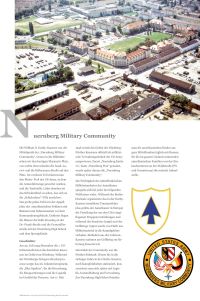
| Nuernberg Military Community
The William O. Darby barracks was the center of the "Nuernberg Military Community". Exactly in the middle of
the photo we see today's Marmaris-Platz, from the top right Isaak-Loewi and Kellermann-Straße open onto the
square. In the front part you can see the US Army's engine pool, in which the army vehicles were serviced,
and the gas station. To the left of it you can see the swimming pool, which adjoined the “Schickedanz” villa.
The large green field was the roll call area for the American soldiers with trees and flagpoles in front of
the command building. Behind it are the Kalb-Housing houses on Dr.-Frank-Straße and Fronmüllerstraße with the
Nuernberg High School and the sports grounds.
History:
On July 25, 1945, the 1st US Infantry Division took over the German barracks in the Nuremberg area. During
the Nuremberg war crimes trials, the 26th Infantry Regiment, the "Blue Spaders", provided security, billeting
and logistics in the area surrounding the trials. On May 17, 1946, the area of the Nuremberg-Fuerth barracks
was officially designated as a military administrative unit of the US Army. First called the “Nuernberg
Enclave”, then called the “Nuernberg Post”, which later became the “Nuernberg Military Community”.
The importance of the Middle Franconian military base for the Americans was reflected in each of the
subsequent world crises. During the Berlin bloc, the transport office installed in the Darby barracks (the
largest of the Americans in Europe) organized the distribution of troop reinforcements flown in from the USA
and during the Suez Crisis (1956) and the Gulf War (1990 ) military material was loaded from Fuerth from into
the combat areas. Units from the Johnson barracks also took part in this war to liberate Kuwait.
The heart of the community was in the southern part of Fuerth. While combat units were still stationed in
the Darby barracks until the 1970s, the focus was later on logistics, maintenance and administration.
American children from all over Middle Franconia were brought to Nuernberg High School every day by buses,
and the shopping center on Waldstrasse (PX and Commissary) was the central point of contact for American
families living all over the area. |
 | Captain Cofer, the first American "Lord Mayor"
Soon after Fuerth's surrender on April 19, 1945, the American stars and stripes blew from a corner of the
Fuerth town hall. A large sign was attached to the main portal:
"MILITARY GOVERNMENT (US)
AREA NUERNBERG
OFFICE FUERTH "
(see photo).
What was behind it? Captain John Daly Cofer (1898-1971), a lawyer from Austin, Texas, was given
responsibility for rebuilding the civil administration in Fuerth after the Second World War. The tasks were
manifold. The task was to maintain the administration and the security of the city despite the war damage,
the lack of food, transport and fuel. Cofer was not a member of the military units stationed in Fürth, but
relied on their support when he needed means of transport.
Captain Cofer "enjoyed the reputation of a correct, calm man with a pronounced sense of justice" and was
considered to be "extremely German-friendly". He had to solve the contradiction of building a functioning
administration without the necessary but Nazi-burdened specialists. “The heads of the two detachments, Cofer
and Whitaker (Ansbach), who at first seemed dark and aloof to some, soon enjoyed a great reputation among the
population. They were valued for their fairness, and above all they were given credit for their ability to
keep the DPs (displaced persons = refugees) in check and for having reversed some of the CIC's mistakes.
Half a year after the establishment of the military government, they were almost in friendly contact with
"their" district administrators and mayors. "
It is not known exactly when Captain Cofer handed over the post of Military Governor to his successor,
Steward Hillard.
(Quotes from "Society and Politics in the American Zone of Occupation" - Hans Woller, Oldenbourg-Vlg.,
Munich 1986) |
 | Confiscated apartments
When they were housed in destroyed Germany, the American soldiers enjoyed priority over the local population,
whose interests were given little consideration. They preferred to requisition the villas of well-known Nazis
and the more settled the "occupiers" became, the more houses they needed. The situation was exacerbated by
the fact that at first Americans and Germans were not allowed to live together under one roof. In addition,
the district masters often generously occupied more rooms than they needed, or they forgot to release houses
that were no longer occupied. The German population was sometimes squeezed to an average of over two people
per room. When billeting, the previous residents often only had a few hours to look for their most important
belongings and find shelter elsewhere. The furniture had to be left behind, even the fruit in their gardens
thwy could not harvest any more when they moved out. And when the house was returned a year later, after a
lot of back and forth, the owners often did not recognize either their apartment or the remains of their
furniture. In a “community of interests of the occupation victims” in Fuerth they tried to put pressure on
the city government and the American military administration in order to get their apartments back as soon
as possible.
An example is shown in the article in the “Fürther Nachrichten” from August 29, 1949 about “Eigenes Heim”.
On May 18, 1945, the apartments had to be vacated for American soldiers immediately. They were later used
as a refugee camp. From 1946 the return was promised several times, but was repeatedly postponed. And it was
not until September 17, 1949 that the “Fürther Nachrichten” reported:
“The relentless efforts of the cooperative administration, but above all the tireless energy and initiative
of the mayor of Fuerth, Dr. Bornkessel and the great human understanding of General David Ruffner for the
reasons presented and the plight of those affected, we managed to finally and completely free the finch
attack come."
"Inscriptions on apartment doors, such as' 3 rd Squad. 7 th. Plat. ‘Or Hebrew lettering above the gate of
a car garage from the Finkenschllag still point to the eventful history that these houses on the outskirts
of the city experienced. ... In the cellars we found loopholes and underground passages, and baths and water
basins that were used as carp ponds were also built in. ... Most of the chimneys have been destroyed because
a lot of gasoline was used for heating. "
(Fürther Nachrichten, December 16, 1949) |
 | Garbage dump at Scherbsgraben
The luxurious American way of life produced a great deal of waste in the barracks and residential areas.
An American living in rent reported: "We found that our two-person household threw about four times as much
rubbish into the garbage can as the family of four of our German landlord". One of the garbage dumps was on
the Scherbsgraben in the first years after the Second World War. What we know today from slums in South
America or Africa took place in Fuerth until the beginning of the 1950s: “The notorious rubble dump at the
Scherbsgraben is really not an edifying sight to the eye. In addition, it is also a treasure trove for the
rubble hyenas, some valuable and useful, but also dangerous and unsuitable objects. A look over the area
reveals a colorful life of avid collectors, including children. Those who are waiting for the next American
car sometimes even light a campfire. How dangerous it is to read rubble is proven by the fact that children
once brought home highly toxic strychnine ampoules to the horror of their parents. ... The police have to be
warned again and again before searching the rubble site because of the risk of infection. ”
(Fürther Nachrichten, February 8th, 1950).
Some American garbage deliverers were generous and allowed the “Gogerers” to take useful things with them.
Others guarded their garbage until a bulldozer plowed in the goods.
Shortly before the final withdrawal in 1995, the Americans even adopted the German system of waste separation.
|

| “Off Limits” - “Forbidden for Germans”
“Off limits” is not always “off limits”. It is well known that the American commander forbade his soldiers
access to the entire old town of Fuerth in November 1954. Conversely, since the end of the war there had also
been many such bans on entry for the people of Fuerth. Not only did the US Army facilities remain closed for
them, private apartments and houses inhabited by the Americans were also not allowed to enter. In addition,
the US authorities declared several main roads in Fuerth to be "military roads" in the first few years after
the war. Only American vehicles were allowed to drive on these roads. For Germans, even loading and unloading
in these streets was forbidden and was only allowed again from February 1946 - and only with special
permission from the police. Disregard was seen as a disturbance of order and the interests of the military
government and was punished with fines. Not even the garbage disposal was allowed to drive on the military
roads, the affected residents had to carry their garbage cans into the side streets.
The “good reasons” listed in the newspaper “Fürther Nachrichten” of November 22, 1950 for lifting all of
these bans could be extended to include the Korean War that flared up recently. The United States simply
needed the young Federal Republic of Germany as an ally and was interested in better relations with the
people. |
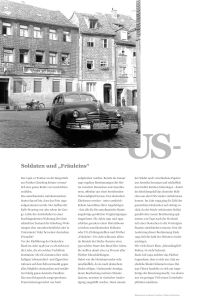 | US soldiers and "Fräuleins"
The 1946 Pontiac on Bergstrasse on Fuerther Gänsberg could probably tell a whole series of stories.
The American license plate indicates that the photo was taken in 1952. The construction of Kalb Housing was
already in progress. Did the car owner live in a confiscated apartment (unlikely given the poor condition
of the Gänsberg apartments) or sublet? Or with his German girlfriend?
Before the introduction of the Deutsche Mark in 1948, it was often not just love that determined such a
relationship. The GIs were able to exchange their rich food and cigarette rations on the black market for
anything and often fed entire German families. The fraternization ban imposed at the end of the war was
soon lifted. Already in January 1947 regulations regulated marriages between Germans and Americans,
apparently out of an existing necessity. The German wives - with the express exclusion of their relatives -
were granted almost all the privileges granted to American nationals. The years 1951 and 1952 experienced
a real marriage boom between American soldiers or US civilian employees and Fürth “Fräuleins”. Each year
around 390 such couples made a covenant for life in the Darby barracks area alone. They made up about
14 percent of all marriages in Fuerth. The marriage procedure was very cumbersome because it was carried
out under German law. Comprehensive applications that took several months to process had to be filled out
in four copies. Then the soldier had to get various papers from America and finally deposit a $ 600 bail -
so that in the event of a divorce the German girl could travel back from the USA. In 1953, the number of
mixed weddings fell to seventy, as a new regulation stipulated that the newlywed soldier had to return to
the United States no later than 120 days after the marriage to a German. Only when this regulation was
loosened at the end of 1954 the number of marriages rose again. How many of these marriages lasted for "life"
is not known.
At the end of July 1949, the Fuerth youth welfare office reported that it had to take care of 1759
illegitimate children. 232 fathers were members of the occupying power, of whom only a small number fulfilled
their maintenance obligations. |
 | City theater and apartments are released
The US Army confiscated not only the barracks and many private apartments for their soldiers, but also a
number of public buildings, such as schools and gyms. The Americans commandeered the neo-baroque Fürth city
theater on May 15, 1945. From October of the same year, the people of Fuerth were allowed two screenings a
week, the Americans used it for six cinema screenings a week. "The Americans have a bad cinema and the Fuerth
people have a bad theater," it was said until 1952.
Then the Fuerth construction company Schönwasser built a “Community Theater” for the American soldiers and
their families in the Kalb Housing that was just being built. It opened on August 27, 1952 with the movie
"Jumping Jacks," starring Dean Martin and Jerry Lewis. General Swartz cuts the ribbon, in the photo to the
right of him is the mayor of Fuerth, Hans Segitz, in a dark suit. Three days later, General Ernest A. Bixby
handed over the declaration of approval for the Fuerth City Theater to Mayor Segitz.
In 1952, the Americans released a total of 22 houses with 51 apartments, seven public buildings and two
larger factories. These included the girls' high school on Tannenplatz, two villas on Dr.-Mack-Straße, the
ASV sports field on Magazinstrasse, the Lohnert sports field, seven office rooms in the town hall and the
Jahnturnhalle. |
 | Administration back in Fuerth hands
With the departure of "Resident Officer" Charles M. Emerick (left in the photo) on December 19, 1951, the
Americans' responsibility for the civil administration in Fuerth, which began on April 21, 1945 with Captain
John D. Cofer, ended.
In the presence of the Lord Mayor of Fürth, Dr. Hans Bornkessel (2nd from left) and the commanding general
of the Nuremberg military area, Ernest A. Bixby (right), told Emerick in the Fürth town hall: "I am sad to
leave Fürth." The American was very concerned about the release of confiscated apartments and Gyms, the
water supply and the construction of the American settlement in the southern city. "We found each other on
the basis of real humanity and real democracy," said Mayor Bornkessel (Fürther Nachrichten of December 21,
1951).
In 1951, many homes and the city theater were still occupied by the Americans, and the US Army was careful
to put their concerns first. But through people like Charles M. Emerick and the changed global political
situation, the winner-defeated relationship began to change into a more partnership-like relationship. |
 | Closing time in Gustavstrasse
Not only in the 21st century is there a discussion about closing times in Gustavstrasse. There were many
restaurants there a hundred years ago and since soldiers were stationed in Fürth, they have also been drawn
to Gustavstrasse.
At some point after the end of the war, American soldiers were prohibited from visiting this area (“Off
Limits”); when exactly could not be determined. In any case, since its abolition in September 1949, the
number of incidents has increased significantly. Fights, robberies and prostitution were the order of the
day, and they could hardly be controlled by the Fuerth police (which at that time still had few authority)
and the military police. In joint discussions, the American military administration, the police and the
Fuerth city administration decided on countermeasures, but these only helped temporarily.
“Auf gehts in der Helmstrasse” is the title of a report in the Fürther Nachrichten from September 1954,
in which 20 GIs were fighting and 100 were watching. A little later it was said from Gustavstrasse: “Close
combat with beer bottles”. In comparison, today's legal disputes over the calming of Gustavstrasse seem
harmless.
The accumulation of incidents in 1954 meant that the commander of the US Army for southern Germany, Major
General Numa E. Watson, on November 6, 1954, called the entire old town of Fuerth to "Off Limits" for all
American soldiers between 5 p.m. and 6 a.m. explained. “Gustavstrasse itself offered a completely calm
picture on the first evening and the first night. Large parts of the population actually took a 'stone
from their hearts', because not only had the noisy soldiers disappeared from the streets, but also the
'American girls' and the light-shy entourage of pimps and smugglers. The damage to the innkeepers affected
is undeniable, ”(Fürther Nachrichten, November 8th, 1954).
The event around the evening leisure activities of the GIs shifted to the area around the barracks, where
it was apparently better distributed. As far as is known, the "Off Limits" in the old town of Fürth has
never been officially lifted for American soldiers. |
 | Soldiers in the barracks
During the Cold War, the US had many foreign bases in Europe and Asia to which it sent its conscripted
soldiers (conscription was not abolished until 1973). As in Fürth, the GIs could be divided into two
groups everywhere: the soldiers who were not interested in the host country, who usually spent their stay
abroad in the barracks, which was usually limited to two to three years ("barracks rats") and the group
that saw the sights and special features of the host country.
Bavaria was a valued stationing destination because of its landscapes, hospitality and beer. The National
Socialist past of Nuremberg exerted an additional attraction on the GIs stationed here.
We do not know to which group the two GIs in the photo from 1949, Deptula and Case, belonged. But the
1941 Buick with which they posed in front of the team building on Balbiererstrasse suggests that they
might have taken trips to the Franconian area after all. At that time the US dollar was still very popular
(1 dollar = 4.20 DM) and the soldiers could afford a lot. Later, in the 1970s, the price had fallen
significantly and GIs could even be seen rummaging through the bulky waste in Fürth. |
 | William O. Darby Kaserne
The roll call area of the William O. Darby barracks was located between today's Isaak-Loewi and Dr.-Frank-
Strasse. The building in the background served the US Army as an advisory center and library. The
characteristic clock tower is hidden by a tree. The P&P administration later moved into the building.
In the background you can see the two “Radio Towers” from the AFN. The lattice mast was demolished soon
afterwards, the concrete mast not until 2008.
Since the 1950s, all important changes of command took place on the roll call square, as the headquarters
of the administration of the Nuernberg Military Community was located in the building on Dr.-Frank-Strasse.
The photo from October 28, 1993 shows the dissolution of the 99th ASG. This “Area Support Group” was the
largest in Germany and was only set up in 1991 as the successor to the “Nuernberg Military Community”,
which had shrunk due to the withdrawal of troops. Two years later, when the US Army had closed further
barracks, their assignment was already over, the US military administration in Fuerth lost its previous
independence and was placed under Grafenwoehr.
Two years later, on December 19, 1995, Major Lee Taylor symbolically presented the keys to the completely
cleared US property to the Lord Mayor of Fuerth, Uwe Lichtenberg. The chapter of the US Army in Fürth was thus
concluded.
Today the P&P company manages its extensive construction activities in Fuerth (still) from this building. |
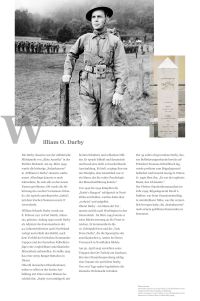 | William Orlando Darby
The Darby barracks was the military center of "Little America" in the southern part of Fürth. On March 29,
1949, the previous “Sedankaserne” was renamed “William O. Darby” Kaserne. However, it took decades for
everyone to get used to the new name. The abbreviation of the middle name Orlando, the typical American
"initial", was often confused with the Irish prefix O '.
William Orlando Darby was born on February 8, 1911 in Fort Smith, Arkansas. At the beginning of 1942 Darby
was transferred to Northern Ireland as adjutant to the commander of the 34th Infantry Division and was
ordered to set up a comparable American elite unit based on the model of the British commandos and the
German paratroopers. He put the first Army Ranger Battalion into service in 1942. Although he is now a
lieutenant colonel, he himself took part in the tough training. One of his men described him: “Darby was
of medium height with broad shoulders and slender hips. He spoke lively and dynamically and had an aura
that could not be described. It was said that it was all about discipline, but in fact he was a man who
knew the true psychology of leadership. "
From 1942 to 1944, the "Darby's Rangers" fought successfully in North Africa and Italy, but were "burned
up" and dissolved. Colonel Darby - a man of action - had to go back to Washington to serve on the General
Staff. In March 1945 he was able to get his transfer back to the front. He commanded the 10th Mountain
Division and the "Task Force Darby", which formed the spearhead of the American 5th Army on its advance
into northern Italy.
On April 30, 1945, his troops reached Torbole on Lake Garda. During a briefing, a grenade struck and
killed Darby. Only two days later the German Wehrmacht capitulated in Italy. Darby, 34 years old, whose
certificate of promotion was already on President Truman's desk, was posthumously promoted to brigade
general and General George S. Patton Jr. said of him: “He was the bravest Man I knew."
The Fürth site commander in 1949, Brigadier General David L. Ruffner, was in the immediate vicinity when
the grenade struck, which presumably prompted him to name the “Sedankaserne” after his fallen mate.
[from 27]: [27] Camp's namesake ranger leader, innovator, hero - Jeff Fry, magazine (title unknown)
dated 08/20/88, owned by the author |
 | Johnson Barracks
The Johnson Barracks emerged from the former tank barracks of the German Wehrmacht. It was bordered
by Schwabacher Strasse and the Main-Danube Canal in the extreme south of Fuerth and covered 51 hectares.
The first buildings had been built shortly before the First World War and had served first as quarters
for a machine gun company and later for a heavy artillery unit of the 21st Infantry Regiment of the
Reichswehr. Between 1920 and 1934, the tank barracks shared the fate of the Sedan barracks (Darby) as
accommodation for the poorer population. In the Nazi era, more buildings were added and Anti Tank
Regiment 17 moved in. In 1935, the large southern part was set up with the huge warehouses (shown in
the photo at the top of the picture), which served as food stores for the Wehrmacht in the entire
Nuremberg-Fuerth area.
After it was taken over by the Americans in May 1945, the tank barracks were renamed Johnson Barracks.
The US Army stationed various engineer units on the extensive area. In 1972 they built one of two US
prisons in Germany on the embankment of the Main-Danube Canal. In the last, not yet demolished, large
former Wehrmacht warehouse, the American DRMO sold used military equipment after the withdrawal from
1995 until August 2002, before this house also fell victim to the demolition excavator.
The namesake of the Barracks, Elden H. Johnson, was born in Bivalue, New Jersey, and his date of birth
is unknown. He enlisted in the American Army in East Weymouth, Massachusetts, and died as a simple
soldier in the 15th Regiment of the 3rd Infantry Division on June 3, 1944 at Valmontone near Rome in
Italy. Although he and his comrades were ambushed and exposed to the hostile hail of bullets at close
range, Johnson had fought down a machine gun nest and, despite many wounds, fired himself to the last
breath to cover the retreat of his twelve comrades. For his bravery in the face of the enemy, Johnson
was posthumously awarded the Congressional Medal, an honor that only 434 American soldiers had received
during World War II. |
 | Open-door day
There weren't many opportunities for the people of Fuerth to get to know the interior of the American
barracks in their city.
During the German-American Friendship Weeks - usually at the beginning of May - the US Army often
opened its barracks for a day. The Army not only displayed their war weapons and equipment, but also
offered hamburgers and the very popular American icecream to the guests.
The photo above was taken to mark the 200th anniversary of the American armed forces on June 14, 1975
at Johnson Barracks. The "DRMO" was housed in one of the large warehouse buildings (as shown in the
second photo). The Defense Realization & Marketing Office sold used office and household items from
army stocks to civilians who had access on individual days. “... Desks, chairs, tables, cash registers,
VCRs, televisions and miscellaneous. Everything is sold as seen and everything must be taken away by 4 pm
on the day of sale. ”(Stars & Stripes, July 27, 1995).
In the case of the electrical devices bought at auction, one had to pay attention to the 110 volt voltage
and the 60 Hertz frequency, which is usual for the Americans. |
 | Kalb Housing
After the founding of the Federal Republic of Germany on May 23, 1949, the US armed forces actually
wanted to withdraw from Germany. However, the tensions between the Soviet Union and the Western Allies
required a longer presence of American troops in Germany. The Nuremberg-Fuerth area with its proximity to
the Iron Curtain and its many barracks offered itself.
Housing was required for the soldiers and their relatives. Immediately after the war, the Americans simply
confiscated the most suitable buildings in Fuerth. This included villas in Dambach and on Espan as well
as many of the undamaged residential buildings. The furniture and gardens, including the fruit hanging on
the trees, were included. In addition, they seized school buildings, gyms, the Park Hotel and the city
theater. For the population of Fuerth, the housing situation, which was already tense due to bomb damage
and the influx of displaced persons from the east, worsened dramatically.
In the early 1950s, the US Army began planning the construction of homes for soldiers and their families.
Because of its proximity to the barracks, only the area south of Fronmüllerstrasse was actually considered
in Fuerth. But there were allotments there, the remains of which can still be seen in the photo at the
top right. Much of the gardens were demolished.
The first residential buildings were built in the spring of 1950 with the participation of Schönwasser,
Röllinger, Hummel & Baumann, Makovsky and Richter & Ohm north of Fronmüllerstrasse, between
Bürkleinstrasse and Darby Kaserne. A total of over 1500 workers worked on the 27 apartment blocks. In
May 1951 the American gas station was opened on the corner of Schwabacher Strasse and Fronmüllerstrasse
(top left of the picture). And when the American school was inaugurated at the beginning of January 1952,
already 200 families were living there. The "Johann von Kalb School" was built in just eight months and
offered space for 1,000 students with 35 American and eight German teachers. Due to the concentration
of American students in the southern part of the city, some of the occupied Fuerth classrooms could be
released. When the school was named, the name of General Jean de Kalb from the American Wars of
Liberation, who was born in Hüttendorf near Erlangen, appeared for the first time. Later the whole
settlement was named after him. |
 | PX - the American shopping mall
For American families, the “PX” (“Post Exchange”) was the central shopping center. Not only did the
Americans living in the south of Fürth shop here, many came from all over Nuremberg-Fürth. In the
other barracks there were small “shopettes” for daily needs, but the more extensive range was between
Leyher Strasse (in the picture above) and Waldstraße (center).
In the large E-shaped main building, the former Army Clothing Office of the Wehrmacht, you could buy
everything from toys and clothing to electrical appliances. The Americans got their groceries in the
small building to the right, the “Commissary”, before a new building was erected south of Waldstrasse
in 1986 (today the Dehner Garden Center).
In these buildings and along Waldstrasse there were other facilities necessary for the daily life of
the Americans: hairdressers, car dealers, insurance offices, a bank and a post office. Likewise, ice
cream parlors, cafes and the usual American fast food chains.
The black factory halls to the west of Waldstrasse, visible in the photo from 1957, represent a special
story. In 1952 there was a long tug-of-war around the three residential buildings and the five German
toy factories, which work almost exclusively for export. The owners urgently needed the halls for their
production. The US Army wanted to accommodate around 200 “Labor Service” men on the site conveniently
located near the Darby barracks. Despite the efforts of Lord Mayor Dr. Bornkessel and the Federal
Chancellery, the Americans insisted on the confiscated site. After long, disappointing negotiations
with various federal ministries, the three remaining companies Neuhierl, Reulein and Kirschner finally
received a new plot of land on the corner of Waldstrasse and Flößaustrasse in February 1954 with the
help of the city of Fürth, where later the Carrera toy company settled down. |
 | How did American families live?
The US Army took great care of its soldiers stationed abroad. For many of the mostly young GIs it was
their first trip abroad and their first contact with a foreign language and culture.
When they arrived, they mostly ended up in the “Bavarian American Hotel” at Nuremberg Central Station
for the first few days before they were distributed to quarters inside or outside the barracks. In the
barracks there were separate offices for all administrative matters, from the personnel department to
the tax office to the driver's license office. They could be reached by mail via an APO number,
independent of the German post.
Department stores ("PX", Shopette, Commissary) offered all the goods for everyday life, and American
mail order houses offered many items from the United States. The barracks had a wide range of leisure
activities, from the cinema and bowling alley to photo and handicraft clubs. As is customary in the USA,
the care of the children in kindergartens and schools was extended throughout the day.
While the single GIs found accommodation in the barracks, the married soldiers either lived in the Kalb
Housing or rented an apartment on the free housing market, the “economy”. For this they received rent
subsidies and often found contact with German neighbors or landlords.
For those interested in the country and its people, there were German courses and lots of information
on leisure (e.g. folk marches) and for travel (from Neuschwanstein to other European countries).
The Americans were able to establish further contacts through the approximately 4,000 German civilian
employees in the “Nurnberg Community”. These worked as craftsmen, office workers or child carers in the
barracks. This made the Americans one of the largest employers in the city.
From hundreds of comments from GIs returned to the US, it can be concluded that most of them enjoyed
their stay here. |
 | Dambach Housing
The Dambach officers' settlement was built in 1956 on 12 hectares of arable and allotment gardens between
Hardenbergstrasse and Forsthausstrasse. In the meantime, the Kalb Housing had been built for the NCOs and
men of the US Army and their families. The officers still live in confiscated houses, among other things
in villas in the neighboring western suburb.
Unfortunately, the American authorities in Heidelberg insisted on an architecturally rather monotonous
construction method for the 33 double and 11 single-family houses of Dambach Housing. It was designed by
the architect Frank C. Throll for American settlements and it should help save construction costs.
The curved streets, which are mainly named after German composers, are characteristic. The plots managed
without fences, the lawns and playgrounds were freely accessible.
Who still knows the “Villa Größenwahn" (megalomania) or Scheibenreif villa? Parts of their surrounding
park with old trees were needed for the officers' settlement. Even then, the city had a number of trees
dug up and replanted in the city park.
When the last American officer's families left the houses in 1995, the federal property administration
put the houses on the open market. The good equipment with parquet floors, thermal insulation and open
chimneys and the quiet location meant that soon all houses found new owners. The sanitary facilities to
be renovated and the polluted floors meant additional expenditure after the purchase.
Decades after the conversion, the settlement, which used to appear “typically American” with large open
spaces, looks more like a German suburb. Fences, hedges and prohibition signs clearly demarcate the
properties from each other. The mostly carefully tended gardens reflect a lively settlement. |
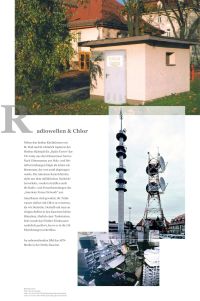 | Radio waves and chlorine
In addition to the two church towers of St. Paul and St. Heinrich, the "Radio Tower" of the US Army
protruded from the sea of houses in the southern part of Fuerth. After lattice masts made of wood and
metal struts, the last was a concrete mast, which was only removed in 2008. The antennas on it were
not only used for military communications, but also broadcast the radio and television programs of the
"American Forces Network".
Americans are used to adding more chlorine to their drinking water than the Germans. Therefore, in some
places in the barracks, one saw small houses, similar to a transformer station. There, the Fuerth drinking
water was also chlorinated before it flowed on to the US facilities. |
 | Monteith Barracks
The Monteith Barracks was located on a hill between the village of Atzenhof and the Farrnbach in the
north-west of Fuerth. At the beginning of the 20th century, the heather and pasture area was chosen as an
airfield because of its high location, its proximity to the city and its lack of fog. During the First
World War, a flying school was built there, the first halls and quarters were built, access roads were
built and a siding was laid to the Wuerzburg-Fuerth railway line.
After the First World War, the old military planes that had been converted for passenger and parcel
transport flew to the new Fuerth-Nuremberg airport. A restaurant opened in the former officers' mess.
Up until the Great Depression, the airport grew to become the eighth largest in the German Empire.
Junkers-Flugzeugwerke operated its own aircraft yard on the site and Fuerth-Atzenhof became an air hub
in southern Germany alongside Munich-Oberwiesenfeld. When Nuremberg opened its own airport at Marienberg
on August 20, 1933, only sports aviation remained in Fuerth.
But as early as 1934, the National Socialists were using the "Fuerth Air Base" for the Luftwaffe. Various
pilot schools were stationed on the field until the end of World War II.
After Fuerth surrendered in April 1945, the Americans occupied the site and first called it "Furth Air
Base". On May 11, 1949, it was renamed Monteith-Barracks (other sources cite May 30, 1952). Jimmie W.
Monteith Jr., (born July 1, 1917 in Low Moor, Virginia) died on June 6, 1944 near Colleville-sur-Mer in
Normandy as a lieutenant in the 16th regiment of the 1st Infantry Division . On the day of the invasion,
he organized the attack in his combat section and exposed himself to enemy fire on the open beach. Walking
ahead, he also directed two tanks through a minefield. Then Monteith and his people conquered an important
hilltop position, again not paying attention to the hail of bullets. First lieutenant Monteith died when
German soldiers succeeded in encircling his unit after repelling several counter-attacks. Jimmie W. Monteith
was posthumously awarded the Congress Medal for his bravery.
In the years that followed, the Americans made only a few changes to the buildings of Monteith Barracks.
In 1952, an 850 meter long asphalt runway was laid out, which has now disappeared under a hill equipped with
solar modules. First, units of the 4th US Armored Division occupied the barracks. Because of the Main-Danube
Canal, the barracks area had to be redesigned and the army pilots moved to Katterbach. Support units of the
1st US Armored Division followed until the Monteith Barracks were closed on September 19, 1993. |
 | Normalization of the relationship
After the completion of Kalb-Housing in the Suedstadt in 1955, the US Army was able to release all
confiscated apartments and houses in Fuerth and the relationship between the population and the "occupiers"
normalized.
The young US President John F. Kennedy, elected in 1961, was very popular with the German population and
everyone was shocked when he was assassinated on November 22, 1963. The photo from November 25, 1963 shows
the lord mayor of Fürth, Dr. Hans Bornkessel (1892-1977) laying the wreath in the Monteith Barracks together
with Brigadier General John D. Torrey Jr. The Americans were very moved by the sympathy of the population,
especially since the city renamed the Meisenstrasse in the Kalb Housing to of John-F.-Kennedy-Strasse. |
 | Tanks and helicopters
In the first post-war years, the US Army used the Atzenhofer barracks as an airfield to be able to fly in
important visitors. Later the runway was only approached by courier machines.
A brisk flight activity annoyed the residents of the area - even in their own home - nevertheless.
Army aviators of the 4th US Armored Division were stationed in Atzenhof and practiced day and night with
their helicopters. The division's tank crews stationed in Atzenhof waited and looked after their vehicles
on the premises and in the hangars.
The Monteith barracks had their own siding through which the tanks could be loaded for the maneuvers.
Ammunition and fuel were stored in large quantities in the barracks for the combat units. In the 1960s,
the US Army stationed a radar station and Hawk anti-aircraft missiles on the outskirts of Atzenhof.
In the course of the reorganization of the barracks required by the construction of the Main-Danube Canal,
the army pilots and the missile position moved to Katterbach and Illesheim near Ansbach. To this day
there are complaints from the residents there.
After the NATO double decision in 1979, Pershing II rockets were to be stationed in Monteith barracks and
the necessary workshops and accommodation were built. But There any actual deployment probably never
happened. Today, residential buildings, "soft" industry, a school and the Fraunhofer Institute frame the
American golf course that has been preserved. |
 | Assessment of the golf course
At the beginning of the 1950s, the US Army had a course and clubhouse built in the Monteith barracks under
the guidance of the well-known German golf course architect Bernhard von Limburger. The course was within
the barracks area and was normally not accessible to Germans. The soldiers had to play around an ammunition
depot on their fairways and were well protected by a Hawk missile defense system stationed in the direction
of Atzenhof.
When the Main-Danube Canal cut through the barracks in 1969, the golf course was partially relocated and
newly dsigned. New fairways were created between the old Vacher Strasse and the garbage dump of the city
of Fuerth (on the photo you can see the office building and the shredding plant in the background). For
this purpose, some pieces of land even had to be expropriated.
On July 2, 1971, a commission made up of representatives from the Finance Department, the US Army and the
construction company took over the new site. Every bare patch, every damp spot in the lawn was examined,
the depth of the sand bunkers measured. "But as a farmer at the fence put it quite correctly: 'It's better
when they play golf instead of playing war'". (Fürther Nachrichten, July 3rd, 1971)
When the closure of the Monteith Barracks was foreseeable, the 1st Golf Club Fürth, founded in 1992, was
able to play as a guest on the premises and finally in 1997 acquired the entire golf course from the
Federal Property Administration. Many new members joined and the course was gradually improved and a
9-hole short course was added. The location of the course close to the city is an image factor for the
city of Fuerth that should not be underestimated. |
 | Nuclear weapons - yes or no?
The Zennwald depot was located between Burgfarrnbach and Kreppendorf. The total of fourteen bunkers with
a floor area of 100 and 200 square meters were built by the German Wehrmacht between the trees of the
Zennwald and connected by paved roads.
The US Army took possession of the site in early 1957 as a replacement for their depot at Dynamit Nobel AG
in Stadeln. Due to its remote location and the strict security, the depot gave rise to all kinds of rumors
and speculations. Farmers, hunters and harmless strollers who come too close to the fence were arrested by
the guards and the neighboring property owners had to keep a 30 meter wide “death strip” free. Transports
to the depot were sometimes only carried out by officers, and the cargo and accompanying persons were checked
with Geiger counters when entering and leaving. In the 1960s, so-called “atomic cannons” with a caliber of
28 cm were stationed in Fuerth, and later 20.3 cm M110 field howitzers. Both types could fire nuclear
warheads, which is why it was assumed that nuclear weapons were also stored in the Zennwald depot. As early
as 1964, the Fuerth hunters protested against the depot close to the city, especially since an
extension of ten hectares was planned with the assistance of the Bundeswehr.
The “Fürther Nachrichten” reported on September 10, 1974: “The disaster alarm triggered a panic yesterday
morning after 11 o'clock in the American ammunition depot in the Zennwald. An ammunition container filled
with toxic chemicals had leaked. The resulting corrosive fumes injured three people in the depot. The local
population, for whose protection a mass contingent of American soldiers, the police and fire brigade had
come up, got away with the horror. ”Rumors about radioactive substances and clouds of poison gas were making
the rounds.
Later only light ammunition was stored in the Zennwald depot, which could be deduced from the decreasing
intensity of surveillance. At the end of August 1991, the US Army surprisingly announced that it had already
cleared the bunkers. The ammunition it contained was transported to the Persian Gulf at the end of 1990.
After that, the depot was no longer refilled. The Fuerth city administration registered its interest in this
area in order to integrate it into the surrounding recreational area. Otherwise it was quiet around the
8.5 hectare site, which the city was able to take over free of charge from the federal property
administration on July 21, 1994. The purchase price was offset against the high demolition costs of the
bunkers. The "Robin Hood" in the 30-year struggle against the munitions depot in the Zennwald,
Burgfarrnbacher UCS City Councilor Konrad Dürschinger, died in February 1995 and saw the fulfillment of
his wish to transform the depot back into a forest landscape , no more.
(UCS = Independent Christian Social, parliamentary group in the Fürth city council). |
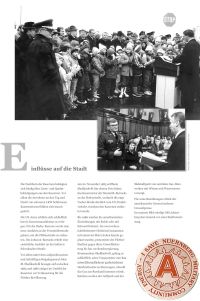 | Influences on the city
The neighbors of the barracks often complained about noise and smoke from the barracks. In particular, the
residents close to the barracks gates that heavy trucks drove through day and night felt massively disturbed.
The US Army finally agreed to relocate barracks exits. For the Darby Kaserne, a new exit was built on
Fronmüllerstrasse to relieve the Flößaustrasse. The Johnson Barracks got an additional exit on the outer
Schwabacher Strasse.
Especially under the open-minded and energetic Brigadier General John M. Shalikashvili, a lot happened in
the area around the barracks between 1984 and 1986 to improve the situation for the population of Fuerth.
On November 22, 1985, Shalikashvili (left in the photo) opened the barracks gate of the Monteith Barracks
on Hafenstrasse, which significantly relieved the narrow Vacher Strasse from US commuting between the
barracks.
Until 1986, the American facilities were heated with coal or heavy oil. When two more coal-fired boilers
were planned together with a 60 meter high chimney, the Fuerth city council protested against this
environmental pollution up to the federal government. Commander Shalikashvili finally managed to convince
his superiors to build more environmentally friendly gas-fired thermal power stations, even though the
gas would come from Russia. Since then, the Golfpark and the Südstadtpark have been supplied with heat
and hot water from central gas heating plants. The American general received several environmental awards
for his efforts. |
 | US cars in Fuerth
American cars were always present in the city of Fuerth until the US Army withdrew in 1995.
In the first few years after the war there were only a few German cars and trucks, while the US Army was
fully motorized. Later, when the first families of soldiers moved in, the number of private American cars
increased. At that time they were still recognizable by their more modern design, the sweeping shapes and
the different number plates. Starting with the VW Beetle, more and more GIs bought European or Japanese
models. You could only recognize the American owners by the shape of the license plates and the differently
switched brake and indicator lights. When the attacks on US soldiers by terrorists increased in the 1980s,
they were also able to receive German license plates for their cars. Since then it was hardly possible to
recognize American cars. Fuerth number plates with the number combinations FÜ-CK, popular with the GIs as
souvenirs, disappeared again and again from German cars ...
The photos show a 1963 Chevrolet Impala at the Grüner Markt and a 1952 Buick at Heiligenberg.
The GIs rarely walked and only went in uniform in the immediate vicinity of the barracks. They could only
be recognized in the city if they were either dark-skinned or wore the large-checked jackets or trousers
that are widely used in the USA. |
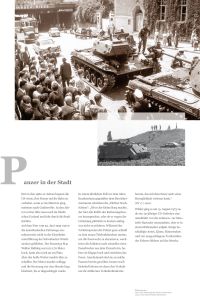 | Tanks in the city
It was not until the 1980s that the US Army began to load its tanks onto the train when it came to
maneuvers, mostly to Grafenwoehr. In the years before, the maneuvers were held in the Franconian region
and the tanks drove through the city.
In the photo from June 25, 1959, the American vehicles were, exceptionally, not stuck in the railway
underpass on Schwabacher Strasse. The tank type M41 Walker Bulldog was only 2.70 meters high, so there was
still 90 cm of space. But the hot weather bothered him. The engine stalled and the intersection was blocked
for an hour before it was towed.
In a similar case in front of the Old Hospital across from the Berolzheimerianum, the “Fürther Nachrichten”
wrote: “Whether it was the little mountain that claimed all the strength of the chain monster, or whether
it suddenly began to boil because of a detour, was not known. While the police traffic post ran very
quickly to the new telephone booth to alert the fire brigade, the soldiers heaved a fire extinguisher out
of the armored turret even faster, lifted a flap and smothered the fire. Apparently they are already used
to such mishaps. Still smiling, they then guided the traffic around their steel traffic obstacle, which
had also lost its mobility with the fire. ”(FN 17.7.1962).
Things went wilder on August 15, 1973, when a 19-year-old US corporal went on a rampage from the Johnson
to the Monteith Barracks, before he gave up in a beet field. Some damaged cars, fences, corners of houses
and four knocked out front teeth of the driver were left behind. |

| Accident at Heiligenberg
Today, one can no longer imagine that there was neither a south-west bypass, a Frankenschnellweg (A73)
nor a highway northbound in and around Fuerth until the 1970s. The federal highway No. 8 ran right through
the city. At the end of the 1950s, at least Gustavstrasse and Königstrasse were made into one-way streets
in opposite directions, so that traffic no longer congested at the narrowest part of Königstrasse.
With its many small and large vehicles, from jeeps to tanks, the US Army contributed significantly to the
volume of traffic in downtown Fuerth. After all, you had to go from the headquarters of the Nuernberg
Military Community in the Darby Kaserne in Suedstadt to the barracks in Atzenhof and Erlangen through the
center of the city. The narrow streets with the slippery cobblestones were not necessarily suitable for
heavy traffic.
The photo from August 4, 1970 shows a US articulated lorry whose load, empty pressure vessels, including
trailer, crashed into an empty house on Heiligenstrasse. The house, which the city had already bought for
demolition the day before, was now in acute danger of collapsing and had to be torn down immediately.
For that time Heiligenstrasse was closed to all traffic. The entire row of houses was later demolished.
In their place are now the new "city wall" houses on the "Nordspange". |
 | Crime and Justice
The relationship between the American soldiers and the people of Fürth was not unclouded.
Even the normal military service operations in the barracks in the middle of a city offered sufficient
areas of friction. It doesn't matter whether it is traffic or noise. The latter was particularly
troubling for the neighbors of Darby Kaserne. They complained about noisy forklift trucks and humming
power generators, mainly during the night.
Like young people all over the world, the GIs looked for variety and adventure in their free time. In doing
so, they often went over the limit, which was exacerbated by high levels of alcohol consumption and later
drug use. Most of the offenses involved theft and property damage. The soldiers sometimes lifted a small
Goggo automobile on the roof of a house or took masses of beer mugs with them at church fairs. Fights and
serious traffic accidents caused more trouble. Violent crimes, from robberies and rape to murders,
repeatedly made headlines in the local press and a topic of conversation among the population.
The iron memorial cross commemorating the death of Rudolf Stahlhofen can still be seen on Stadelner Strasse.
The taxi driver was shot dead by two US soldiers on September 21, 1971. Thanks to the good cooperation
between the people of Fuerth and the American criminal police, the two perpetrators were caught two days
later. The Nuremberg-Fuerth district court sentenced the two young people to a maximum sentence of ten years
in prison.
The increasingly better relations between the Federal Republic of Germany and the USA led to an amended
occupation statute. The executive and judiciary were also transferred from the American to German
authorities. After the war, the American Military Police ("MP") had the sole say and even arrested Fuerth
police officers if something did not suit them. Later the cooperation worked well, the Fuerth police were
given access to the barracks in order to be able to investigate there and arrest suspects. Initially, the
judiciary was carried out by military courts, which - often wrongly - were suspected of being too lax by
the people of Fuerth. Later, misconduct by soldiers outside the barracks was only tried in German courts. |
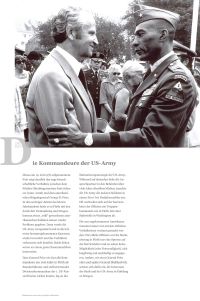 | The commanders of the US Army
This photo, taken on July 19, 1976, clearly shows the close friendship between the Mayor of Fuerth Kurt
Scherzer (1920-2006) and Brigadier General George B. Price.
In the sixties of the last century there had been repeated problems in Fuerth with the American soldiers
who had become somewhat “wild” due to the Vietnam War and drug consumption. Then the US Army was
reorganized and reinvested in the partially run-down barracks, and the ratio improved significantly.
Both sides were interested in a good coexistence.
The fact that General Price, like almost all commanders, was only able to act as senior site senior and
deputy division commander of the 1st US Armored Division in Fuerth for two years was due to the deployment
strategy of the US Army. While on the German side the contact persons in the authorities remained the same
for many years, the US Army changed most of the soldiers every two to three years. Often a troop command
as in Fuerth alternated with a staff position in Washington on the officers' career ladder.
The Americans always had to be familiarized with local conditions first. For a number of officers, being
stationed in Fürth was just one step on the career ladder and they saw no possibility (or necessity) to
get involved in the long term. Others, such as General Price or later General Shalikashvili, worked to
reconcile the interests of the city and the US Army. |
 | Friendship
The relationship between the commander of the US garrison in Fuerth and the Fuerth city administration was
often not just official. People met at meetings, receptions and often in private apartments. Many a
problem could be discussed and solved on the "small official channel".
The very good German-speaking General Jack O. Bradshaw had just tapped the first barrel of Tucher beer on
July 29, 1981 at the German-American folk festival on the high school grounds. He was watched carefully
by the mayor of Fuerth Heinrich Stranka (1922-1983). “Stranka's particular love was the Americans, their
way of life and their culture. For many years he was president of the German-American Men's Club [GAMC]
and contributed significantly to the good relations between Germans and Americans. In general, he was
interested in other cultures in addition to politics, which was his life, and he met people without
prejudices." (FuerthWiki).
In the many cases in which there were points of contact between Germans and Americans, friendships often
developed, and quite a few marriages were concluded. On the Christmas holidays, many US soldiers were
invited to German families to celebrate the festival together. There were German-American clubs like
the GAMC mentioned above, the Woman’s Club, founded in 1949, the Sunshine House and the Kontakt Club.
Until the US Army withdrew from Fürth in 1995, these clubs offered a good opportunity for both sides
to get to know each other's cultures and to deepen their language skills. The US citizens still living
here are mostly integrated into German society. |
 | Army bands
There have been many occasions when the popular Army Music Corps performed. Most of the people of Fuerth
will remember the American bands at the (earlier) Carnival and Thanksgiving parades. The photos show
them at Fürther Freiheit and in Seukendorf.
You could hear the typical "sound" from afar, it was clearly different from that of the German brass
bands. In addition, there was the rehearsed, exact parade step, sometimes even with choreographic
interludes.
In the past each US division had its own band, now there is only one for all of Europe.
The US Army often supported the Fuerth parades by providing large trucks or semi-trailers for floats. |
 | Assistance
In the immediate post-war period in particular, the soldiers stationed in Fuerth supported children
and the needy with food through charity campaigns. Later they actively participated in various
campaigns such as “clean landscape” and provided trucks for the removal of the garbage.
Sometimes there were ground movements to be carried out in Fuerth, which should be carried out quickly
and unbureaucratically and which should not cost a lot. The heavy construction machines of the 16th
Engineer Battalion from the Johnson Barracks were often used for this.
Of course, the willingness of the US Army to help depended on the will of the officers in charge and
on the availability of the units and machines, but on the other hand they were able to practice
realistically in this way.
As early as 1954, an American bulldozer leveled the area on the Scherbsgraben to prepare the lawn
for the summer pool. Years later, the neighboring site of the old Leimsud was leveled to create
parking spaces for visitors to the pool, and the ground for the AW retirement home was prepared
in Burgfarrnbach. As part of a "maneuver", the US Army prepared the grounds of Tuspo Fuerth (see
photo from September 20, 1978) and saved the club 80,000 marks. Armored recovery vehicles
straightened overturned excavators and when the Dambacher Bridge was dilapidated, the pioneers
quickly pushed a temporary bridge over the river. |
 | Boat races on the canal
For a number of years there was the "Hafenfest" organized by the workers' welfare organization at the
Fuerth harbor of the Main-Danube-Canal.
The American soldiers from the neighboring Monteith Barracks liked to visit the big beer tent and took
part in the rubber dinghy races with great enthusiasm.
The GIs who were happy to spend and consume were welcome guests at all church fairs and festivals. |
 | Empty barracks
On the photo from September 5, 1986 Fuerth Lord Mayor Lichtenberg observes how soldiers of the 16th
Engineers Battalion from the Johnson Barracks assemble a makeshift bridge and push it over the
Rednitz near Dambach. The wooden previous bridge was closed on July 31, 1986 due to dilapidation,
the important connection to the Dambach district was interrupted. On September 3, after the efforts
of the site commander, Brigadier General Paul R. Schwartz, the decision was made to use a temporary
bridge for the US Army. The next day, the bridge from a depot in Germersheim am Rhein had already
arrived in Fuerth, and one day later it was reassembled and pushed across the river. A few days
later, a second, identical construction was placed next to it. The makeshift bridges were in use
until the Dambach Bridge was rebuilt in 1988.
During the term of office of Mayor Uwe Lichtenberg (1984-1996) the US Army withdrew from Fuerth, the
barracks were closed and the first steps were taken to convert the vacant space. Although Fuerth had
not tried hard to get the US Army out of the way like Nuremberg, the barracks and housing areas that
became free were welcome for urban development. Instead of having to engage in hard disputes with
Erlangen and Nuremberg about the planned joint Knoblauchsland industrial park, the city suddenly had
more than 270 hectares of space for business and residential construction. |
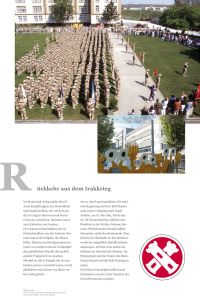 | Return from the Iraq war
During the First Iraq War, the US Army sent combat troops from Germany to Saudi Arabia in order to
liberate Kuwait, which was occupied by Iraq in August 1990. This also included units from Franconia.
The total of 895 soldiers of the 16th Engineer Battalion from the Johnson Barracks had the task of
destroying the minefields, rockets and hand grenades of the Iraqis and, as champions, to clear the
dangerous path for the troops that followed. Fortunately, although they were all involved in fighting
with the Iraqis, none of them were injured or even killed.
The Iraqi government surrendered on April 12, 1991, and about five months after its relocation to
Saudi Arabia, on May 10, 1991, the 16th US Engineer Battalion officially celebrated its return to the
Johnson Barracks in Fuerth. Lieutenant Colonel Ronald Adkins returned to command. The battalion flag
carried along was raised as a sign of returning to the site. In the photo the soldiers are standing
in the courtyard of the barracks. In the back you can see the embankment of the Main-Danube Canal
and the Kalb Housing.
The former Paradeplatz now forms the inner courtyard of the complex commercial center
(photo from 2012). |
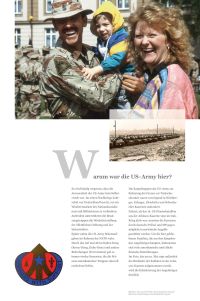 | Why was the US Army here?
It is often forgotten that the presence of the US Army was not an end in itself. In the first post-war
decade, Germany was occupied to prevent National Socialism and militarism from gaining strength again.
In addition, the occupation forces supported the restoration of public order and the infrastructure.
The US Army later took on protective tasks within the framework of NATO. Due to the ups and downs in
the Cold War (Korean War, Cuba Crisis) and other threats (terrorism), there were repeated scenarios
that made the presence of American troops appear sensible. The combat troops of the US Army to secure
the border with Czechoslovakia were mainly stationed in Nuremberg, Erlangen, Zirndorf and Schwabach
barracks.
Most recently, when the 16th US Pioneer Battalion from the Johnson barracks was active in the Iraq
war in 1991, the barracks had to be protected against possible terrorist attacks by the German police
and MP. Many American and several German institutions took care of the families who remained here,
who feared for their relatives in war.
Photos taken on May 10, 1991 on the occasion of the soldiers 'return to the Johnson barracks show
the relatives' relief. |
 | "The most beautiful and most modern school in Bavaria"
At the beginning of the 1950s it was clear that American soldiers had to remain permanently stationed
in Germany and the GIs in the Fürth barracks were allowed to bring their families to their home
countries. Large apartment buildings were built for them in the southern part of Fuerth, and the
Kalb Housing was built. Schools were required for the children. At first she was placed in the “girls'
lyceum”, today's Helene-Lange-Gymnasium, and in Turnstrasse. However, the buildings should be
returned to German ownership.
Therefore, in 1951 the "Johann von Kalb School", later the "Nurnberg High School" (NHS), was built
on Fronmüllerstrasse. For 2.9 million DM, German companies built several buildings on the site of the
former allotment gardens for up to 1000 students of all grades, who were taught by 35 American and
eight German teachers. When the school was inaugurated on January 2, 1952, the newspaper said it was
“the most beautiful and most modern school in Bavaria”.
Just three years later, the Kalbsiedlung had grown to over 1200 apartments and the school had to be
expanded to include the current left wing.
In the newspaper report of the “Fürther Nachrichten” from 1952 it says: “The school complex is to be
handed over to the city of Fürth”. On October 24, 2002, 50 years later, the Hans Böckler School moved
into the building. |
 | American school life
The Nurnberg High School was the school center for all American soldiers' children from Middle
Franconia. The children who lived in the vicinity, such as Erlangen, Schwabach or Nuremberg, were
brought here by school buses every day. Those who lived further away lived during the week in an
outbuilding in the boarding school, the "dormitory".
Unlike the German school system, the Americans spent a full eight-hour day at school. Lunch was
provided by an in house canteen. Homework then still had to be done in the evening - despite the
often long school bus trips.
The teachers were employed by the US Department of Defense. With around 190 full-time and 50
part-time employees (1979), they made up the largest group of American civilian employees in Fuerth.
In contrast to the soldiers, they did not have to change their stationing location every three years.
The Department of Defense had no influence on the curriculum; it applied to all foreign American
institutions worldwide. However, the students had the opportunity to participate voluntarily in
the "Reserve Officers Training Corps". Under the guidance of military instructors, the older children
practiced with the air rifle on the shooting range in the basement of the school and were taught
military science.
The students published their own school newspaper, the “funnel”. Many of the alumni like to think
back to their school days in Fuerth. They started their own organization and still meet today. |
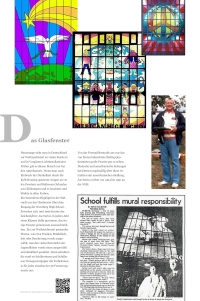 | The glass window
Nowadays in Germany at Christmas time you can see light installations on many windows and in front
gardens. In the past it used to be a custom only among Americans. If you walked through the Kalb
Housing after dark, garlands of incandescent lamps hung on many windows and balconies and it shone
and blinked in all colors.
A special highlight in Südstadt was the glass window above the entrance to Nurnberg High School.
Every year between 1971 and 1990 the drawing teacher Joe Serino was able to convince his classes
to decorate the huge window together. A theme suitable for the Christmas season, such as peace,
brotherhood or giving presents was selected. From the many drafts of the young people, one was
selected and designed in detail. Then the 70 or so students cut out the color elements for each of
the 36 window segments from tracing paper.
The backlit, fifty-square-meter window was easy to see from Fronmüllerstrasse. German and American
newspapers reported regularly about this attraction of the American settlement.
Joe Serino worked at the NHS from 1964 to 1991. |
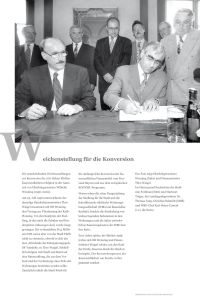 | Setting the course for conversion
The decisive course for the conversion of the barracks area of 270 hectares of Fuerth barracks area
took place during the term of office of Lord Mayor Wilhelm Wenning (1996-2002).
On July 23, 1996, the then Federal Minister of Finance, Theo Waigel, signed the contract for the
provision of Kalb-Housing together with OB Wenning. The purchase price of the settlement, in which
the schools and kindergartens are also included, was a long struggle. However, the negotiated 87.5
million DM could not be raised by the city of Fuerth, although it was a "dividend from the policy
of détente", according to Theo Waigel. Finally, the city and federal government agreed on an
installment payment, which was to be paid for from the sale and rental of part of the apartments.
In addition, the city of Fuerth received funding from the Free State of Bavaria and from the European
KONVER program for the extensive conversion of the barracks.
The mere redesign of the settlement was a financial feat for the city and the leading municipal
housing association (WBG), but the discovery of carcinogenic substances in the apartments and the
necessary renovation costs almost ruined the WBG.
Two years later, in October 1998, Mayor Wenning and Finance Minister Waigel met again to seal the
city's purchase of the Darby Kaserne. The conversion process of the barracks areas had already
started beforehand. |
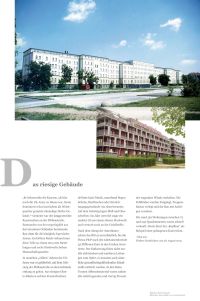 | The huge building
“He ruled the barracks when the US Army was still at home here, today he dominates the former Darby
site, which is now used as a residential area.” This meant the elongated building on Flößaustrasse.
The building, which originally consisted of three individual buildings, was built in 1890 for the
royal Bavarian army. In the Third Reich, these parts were combined to form a crew quarters around
200 meters long and six stories high.
In some of the “wild” years of the US Army, it was dangerous to walk along the pavement of
Flößaustrasse near the building. Loud music boomed from huge ghetto blasters on the window sills,
sometimes shoes, beer bottles or furnishings flew down from above. Trash and broken glass lay on
the sidewalk. In 1970 a naked GI fell from an upper floor and died at the scene of the accident.
After the Americans left, Bld 41 seemed unsaleable until the P&P company invested 35 million Euro
in the renovation after the turn of the millennium. Not only did all electrical and sanitary cables
fall victim to the gutting, all harmful substances also had to be removed. The 8,000 tons of
demolition material also included all non-load-bearing and forty percent of the load-bearing walls.
The false floors were exposed, stairwells were laid and the building was provided with elevators.
The 150 or so apartments between 72 and 240 square meters were sold quickly. Today the "head
building" serves as an example of a successful conversion. |
 | The missing Johnson Barracks
The barracks were on the outskirts of Fuerth. On the first photo from 1969 you can see the avenue
of Schwabacher Strasse leading to the south and a barracks building. A little later, the Main-
Danube Canal and the south-west bypass will lead across the sunken road almost exactly at the
barrier.
Today nothing on the site reminds of the former barracks. The 2008 photo was taken from almost
exactly the same spot and shows the industrial park "Complex". |
 | Disappeared signs
As the administrative center of the Nuernberg Military Community, Fuerth was the main point of
contact for many GIs. For this reason, signs for non-resident US soldiers were posted in many parts
of the city.
On low underpasses - like here on Schwabacher Strasse - the height was often given in American
units ("feet"). However, this did not prevent some GI from attempting to drive through with their
obviously too high vehicle.
Even six years after the withdrawal, not all American reports had disappeared from the shops near
the barracks.
Some scattered Americans had probably stayed in Fuerth. The newspaper machine for the army magazine
"Stars & Stripes" was still on Steubenstrasse many years later. |
 | Conversion of a district
On an official mission, Lord Mayor Dr. Thomas Jung (from 2002) only rarely came into contact with
representatives of the US Army for many years after the troop withdrawal. One reason arose when
on December 19, 2005 - exactly ten years after the last soldiers left - a memorial plaque was
unveiled on what would later become Marmaris Square. “In friendly and grateful memory of the
American soldiers stationed here between 1945 and 1995. They helped to secure peace in Europe ”.
In the photo, Mayor Jung is framed by Colonel Brian T. Boyle, the commander of the US armed
forces in Grafenwoehr (left) and the Munich US Consul General Mathew M. Rooney.
The conversion of the areas previously used by the Americans, which was planned and started under
Lord Mayor Wilhelm Wenning, was continued under Mayor Jung and largely completed. The Kalb
Housing Area, the school center around the Hans Böckler School and the Darby barracks, which
were redesigned for residential purposes, enabled many young families to move in from the
surrounding area. Many "soft" firms have settled in Johnson Barracks. There was only greater
excitement about the short-term planned Bundesliga stadium of the SpVgg, but this was done by
itself through their relegation and the lapwing breeding there. Only in the Monteith Barracks
is there still space available for companies willing to settle. |
 | Südstadtpark
Around 1950, the photographer looked south from building 41, the "head building" along
Flößaustrasse. At that time the parades did not take place in front of Bld 1 on Dr.-Frank-
Strasse, but in the inner area of the Darby Kaserne. In the foreground, a small wooden
stand and maybe even a weatherproof shelter had been built for the better guests.
The white building at the top of the picture is the former production building of the
Schickedanz company. In front of it, the roof of the "villa" and the two roofs of today's
music school can be seen. The buildings in the foreground gave way to the green area of the
Südstadtpark.
After the conversion, the area is the center of the newly created Südstadtpark. It is a
spacious recreational area for residents and is used for concerts and other events. |
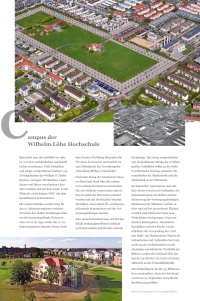 | The campus of the Wilhelm Löhe University
If you look at the aerial photo from 1961, nothing of a park-like landscape can be seen.
Lots of parking spaces, small green spaces and a few trees in the midst of functional
buildings from the William O. Darby Kaserne, garages, workshops, warehouses and offices
of various architectural styles are spread across the area. In the middle is the
“Schickedanz Villa” with an adjacent swimming pool.
The first buildings were erected in 1895 for the 21st Infantry Regiment. Between the two
world wars, the barracks buildings were used for residential purposes before the 21st
Infantry Regiment moved back into quarters in 1935. After the Second World War, the US Army
took over the barracks and made it the center of administration for the “Nuernberg Military
Community”.
After the Americans left, the federal government and the city had to decide on the further
use of the barracks. The 100 buildings had undergone major changes inside and out over time
and were contaminated with insecticides. The floors were contaminated by oil and petrol
residues and the supply lines were ailing.
A decision was made very quickly to preserve listed buildings for residential purposes and
to have a central park. The strictly aligned 350 linden trees along the 9 hectare green area
are intended to remind of the earlier military use. They enclose the music school and the
university in the middle of the square.
In September 1999, the demolition of around 60 buildings, the decontamination of the floors
and the renewal of the supply lines began. Old buildings worth preserving have been
renovated and new residential buildings have been built on the vacated areas to the west and
east of the park. In addition, kindergartens, old people's homes, playgrounds and a church
were built. Unfortunately, the use of the “Green Hall” at the north end of the square as a
culinary and cultural center failed, and in 2018 an architecture firm moved into the former
American gymnasium. All buildings are heated by the heating plant on Fronmüllerstrasse,
which was built at the time of the US Army.
The Südstadtpark, the "oasis of relaxation" created for 5.3 million euros, was opened to
the public on September 24, 2004. |
 | The Schickedanz Villa
The building, which today houses the Wilhelm Löhe University, was built in 1910 on the edge
of a large barracks complex on what was then Artilleriestrasse. The plastered building on
sandstone bases is based on old parcel boundaries, which is why it is at an angle to all
other buildings in its vicinity.
Until 1917 the building served as an apartment for officers before it was converted into an
office building. The shoe manufacturer Ehrlich started using it in 1920, and the mail order
company Gustav Schickedanz moved in in 1932. He acquired an adjacent factory site and from
there sold short, white, wool and woven goods. His company became known as "Versandhaus
Quelle" and was an important employer in the Nuremberg metropolitan region until bankruptcy
in 2009. Although the valuable furnishings of the building indicated its representative
purpose, it is not clear whether Gustav Schickedanz and his family lived in the house for
a long time. The family owned a much larger property in Fürth-Dambach.
Most of the buildings on the factory site were bombed on August 10, 1943. After the Second
World War, the US Army took over the entire barracks and used them until 1995. The swimming
pool next to the villa was used by the soldiers for recreation; the building housed the
chaplain, the driver's license office and an MP station. After the US Army withdrew in 1995,
all the buildings surrounding the villa - garages, workshops - were torn down to make room
for a large green area. A café with a beer garden or at least a “socio-cultural” facility
was imagined as a use for the “villa”. However, due to the small-scale room layout and the
contamination with insect control agents, it was not until 2009 that a buyer was found.
The Wilhlem Löhe University had the roof and floors renewed for almost 4 million euros and
the monument equipped with generous glass extensions.
In 2011 the university moved into the “Schickedanz Villa”. Significantly increasing student
numbers required an extension a few years later, which was to be added to the existing
building. Protests by residents, who absolutely wanted to preserve the park-like character
of the campus, led to the new building being built a hundred meters away next to the
heating plant. |
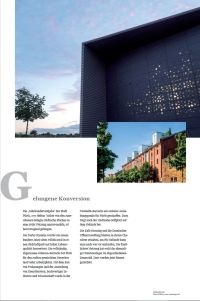 | Successful conversion
The “task of the century” of the city of Fuerth, to convert 270 hectares of urban space
occupied by the Americans into civil use, has been an excellent success.
The Darby Kaserne was converted from a hundred year old military area into a south city
park with a high quality of life. The completely demolished Johnson Barracks provided
space for the construction of mixed businesses and many jobs. With the construction of
apartments and the settlement of service providers, high-quality industry and science,
another point of attraction for Fuerth was created in the Monteith-Barracks. The golf
course near the city also contributes to this.
The character of the Kalb Housing and the Dambach officers' settlement was retained,
and you can still shop on the PX site. The most peaceful use is probably the former
ammunition store in the secluded Zennwald. Bees are now bred there. |
| |